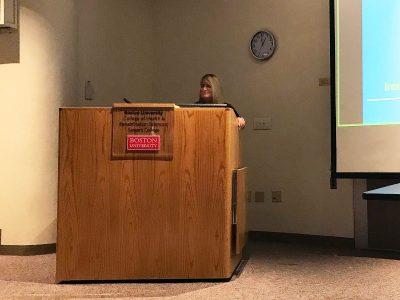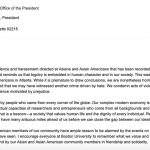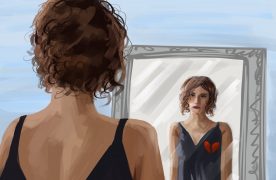
Fitness blogs debate the ideal running shoe across the internet. Each design boasts a range of support, yet Irene Davis argues the best shoe has minimal support.
Last week, Sargent College’s Physical Therapy and Athletic Training Department welcomed Davis, who holds a doctorate in biomechanics, to serve as the inaugural speaker for their new Grand Rounds series.
Her presentation, “Integrating Science into the Treatment of Runners,” focused primarily on how common running mechanics can result in a variety of injuries and the best ways to prevent them.
In total, 75 people registered to attend and 42 people registered to watch the talk via online stream, according to LaDora Thompson, who chairs Sargent College’s Physical Therapy and Athletic Training Department.
The audience was comprised of undergraduate students, graduate students and faculty in the fields of physical therapy and athletic training.
“A real strength of [Davis] is she really builds bridges across many disciplines,” Thompson said.
Davis is the director for the Spaulding National Running Center and a visiting professor at Harvard Medical School. She was named a Catherine Worthingham Fellow in 2010.
During the talk, she presented multiple studies backing the notion that injuries, such as tibial stress fractures and patellofemoral pain (pain in the front of the knee or around the kneecap), are caused by high load rates resulting in part from the shoes people wear.
“When you have shoes that support muscles, the demand of the muscles is going to reduce, and the muscles are going to weaken,” Davis said. “It is just simple physics.”
According to Davis’s presentation, the foot tends to land harder on softer surfaces while the opposite is true for hard surfaces. The cushioning present in most shoes results in people landing harder when running, and the added weight at the heel of one’s foot causes one to assume a rear foot strike pattern.
The pattern is associated with higher load rates and higher rates of tibial shock.
As a result of her own research and existing literature on the subject, Davis said she is a proponent of minimal footwear running and barefoot running.
“Our feet are designed to function without any shoes at all, from an evolutionary standpoint,” Davis said.
According to Davis, the lack of cushioning in minimal footwear possesses many benefits for runners. Firstly, it makes it uncomfortable to land on one’s heel and forces them to land on the ball of their foot, which is how humans were naturally adapted to run.
The lack of support also promotes strengthening in the muscles of the foot and supports a forefoot strike pattern as opposed to a rear foot strike pattern. These combined factors are shown to result in much softer landings.
“There is a lot of skepticism about minimal footwear because I think that we have gotten lulled into thinking that we need cushioning and support in our feet,” Davis said.
Timothy Willard, a junior in Sargent College, said he was surprised by the potential benefits to minimal footwear running.
“It’s really impressive how much research she has in this,” Willard said. “She developed a method that people can use to fix their mechanics. … It’s cool to see that there actually is science behind it that’s really reputable.”
Davis was quick to point out that minimal footwear was not a newer trend. Prior to the invention of the cushioned shoe in the late 1960s, Davis said all shoes would be considered minimal footwear by today’s standards.
“The idea of minimal shoes is really not new,” Davis said. “What’s new is all the technology that we have in footwear today, such as cushioning and support.”
Davis explained that ideally an individual should be able to roll the minimal footwear into a pocket.
However, if someone is already accustomed to running in cushioned shoes, they should be careful with transitioning to minimal footwear too quickly, Davis warned.
She said most concerns about minimal shoes arise from people expecting to be able to run at the same volume as they were in cushioned shoes immediately.
“That would be like you going to the gym, lifting 100 pounds, and you’ve never lifted, getting injured, and someone saying, ‘Don’t go to the gym again,’” Davis said. “It’s not to me the right approach.”
Davis said taking the time to adapt to the footwear is worthwhile.
“I’m definitely going to look at my shoes when I get home,” Willard said.












